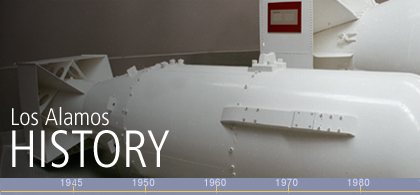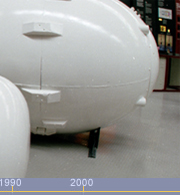
|

OverviewLos Alamos National Laboratory is one of the world’s leading research institutions. Each day, laboratory personnel work on advanced technologies to meet the needs of the 21st century such as hydrogen fuel cell development, super computing, and applied environmental research. Since its creation, however, the primary responsibility of the laboratory has been to maintain the effectiveness of the nation’s nuclear deterrent. Though the world is rapidly changing, this essential responsibility remains the core mission of the laboratory. A Call to ArmsThe Los Alamos Laboratory, or Project Y, came into existence in early 1943 for a single purpose: to design and build an atomic bomb. The United States knew little about the German atomic program, but the specter of a nuclear-equipped Hitler could not be ignored. As American soldiers trudged through the deserts of North Africa, braved the Normandy beaches, and bled for every yard of distant Iwo Jima and Okinawa, American scientists raced to unlock the power of the atom. On May 8, 1945, hostilities ceased in Europe, but war raged on in the Pacific as the armed forces of Imperial Japan grew more determined with each setback. By the summer of 1945 Japan’s Pacific-wide empire had crumbled. However, Japan’s ability to wage war remained largely intact. Time and again, the Japanese suffered defeat on the battlefield. The ferocious resistance of Japanese soldiers in the field was matched only by the stoic determination of their leaders in Tokyo. The Japanese had literally fought to the last man for dozens of tiny outposts including Tarawa, Enewetak, and Tinian. A struggle of equal savagery was expected as the Allies prepared to invade the home islands. The Atom and the End of World War IIOn July 16, 1945, the world’s first atomic bomb was detonated two hundred miles south of Los Alamos at the Alamogordo bombing range. Under the scientific leadership of J. Robert Oppenheimer and the military direction of General Leslie R. Groves, scientists at Los Alamos laboratory had successfully weaponized the atom. With Germany defeated, President Harry S Truman chose to employ the bomb against Japan. Atomic bombs fell on the cities of Hiroshima and Nagasaki, respectively, on August 6th and 9th. These atomic attacks finally broke the will of the Japanese nation, and on August 14th, World War II officially ended after years of slaughter. An invasion of the Japanese home islands proved unnecessary, thus sparing thousands of American as well as Japanese lives. The Cold War is LaunchedUnfortunately, the thrill of victory proved fleeting. A new enemy, the Soviet Union, emerged to fill the power vacuum left by the dual collapses of Germany and Japan. Before the war, Soviet Premier Joseph Stalin conspired with Hitler to crush Poland. Stalin also invaded Finland and forcefully annexed the Baltic States and large portions of Romania. At war’s end, Stalin could claim mastery of all Eastern Europe. Four years later, in 1949, he could also claim ownership of an atomic bomb. That same year, China fell to Mao Zedong’s communist insurgents. The aggressive expansion of communism resulted in a new American strategy: containment. Scientists at Los Alamos perfected the weapons with which the United States halted communist aggression in Europe, the Middle East, and much of the Far East. The power of the atom, with all its potential for mass destruction, has protected the freedom of people the world over. |

Contacts
|